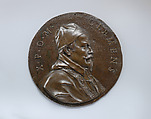Pope Clement X
Girolamo Lucenti
After a model by Gian Lorenzo Bernini Italian
Pietro Cannata relates this large bronze depicting Pope Clement X to a group of slightly smaller portrait medallions featuring the same pontiff and roughly equal in size (27–28 cm).[1] The superior cast is in the Museo Nazionale del Palazzo di Venezia, Rome; others are in Perugia, Raleigh, a private collection, and one formerly in Milan.[2] They differ in some details; for instance, the Perugia roundel is gilt, and the stitching on the camauro of the Raleigh bronze is intermittent and nonlinear. In 1677, Carlo Cartari catalogued a “very large medallion” with a “beautiful image of Clement X by Cavalier Bernino without an inscription [or] a reverse.”[3] Cartari is a particularly reliable source, as he was librarian to Cardinal Paluzzo Altieri (the pope’s nephew) and cousin of Giulio Cartari, one of Bernini’s favorite pupils. Given its outstanding quality, the Rome medallion has been identified as the one Cartari described, and the entire series has accordingly been linked to Bernini. Silvana Balbi de Caro infers that Bernini made a sketch of the pope’s profile and the first model in wax, then delegated the casting to Girolamo Lucenti.[4] An engraver at the papal mint from 1668 to 1679, Lucenti was extensively employed by Bernini for the casting of bronzes.[5] The connection between this medallion and profile sketches of Clement X, one by Bernini and the other by his workshop (Museum der Bildenden Künste, Leipzig), remains unclear. As Cannata notes, the pope looks much older and jowlier in the drawings, which should therefore be dated to the end of his pontificate.[6]
Unlike this group of medallions, ours bears an inscription: X·P[ONTIFEX]·M[AXIMVS]·CLEMENS (Pope Clement X, the highest and the greatest). It is also slightly larger.[7] Only one other cast of this variant is known, in Bologna (fig. 154a).[8] The kinship between the inscribed Met and Bologna exemplars suggest that they are larger casts derived from the inscription-less Rome prototype. Lucenti is indeed a good candidate as the caster of our variant. In fact, throughout 1670, the first year of Clement X’s papacy, Lucenti produced two medals of the pope with slender features, and our medallion might be tied to those commissions.[9] Although a fine cast, it is inferior to the Rome medallion (which should be considered from Bernini’s own hand): the irises are bluntly delineated, the shape of the ear simplified, the facial wrinkles smoothed out, the garments less elegant. Overall, it lacks the subtle modulations and expressiveness of the prototype.
Finally, an even larger, terracotta medallion of Clement X attributed to Bernini (fig. 154b) has been linked to our bronze, but it is difficult to understand why beyond the fact that it, too, has an inscription.[10] However, here the “X” appears on the right side of the roundel, after CLEMENS. The execution is mediocre and the details schematically rendered. Although both presumably portray the pope at around the same age, at the beginning of his reign, the terracotta pontiff is leaner, his pensive gaze cast downward. Rather than a model for our variant, it is more likely a later derivation.
-FL
Footnotes
(For key to shortened references see bibliography in Allen, Italian Renaissance and Baroque Bronzes in The Metropolitan Museum of Art. NY: The Metropolitan Museum of Art, 2022.)
1. On the series, see Cannata 2011, pp. 158–59. See also Bimm 1974, p. 72. I thank Andrea Bacchi for sharing with me his unpublished research on some of the medallions discussed here.
2. Palazzo di Venezia, PV 1637; Museo di Palazzo della Penna, Perugia, 296 (Di Gioia in F. Mancini 2002, p. 174, cat. 104); North Carolina Museum of Art, Raleigh, 70.20.1 (Humphrey 2015); private collection, Milan (Andrea Bacchi, unpublished research; Fagiolo dell’Arco 2002, p. 65). All are illustrated in Humphrey 2015.
3. See Balbi de Caro 1974, p. 19; Cannata 2011, p. 158.
4. Balbi de Caro 1974.
5. See Ostrow 1991; Villa 1996; Simonato 2012; Guido and Mantella 2013.
6. Cannata 2011, p. 159.
7. It was cast in brass with small amounts of lead and tin and trace impurities. R. Stone/TR, 2010.
8. See Stefano Tumidei in Bologna 1997, cat. 63 (which does not discuss The Met medallion); Bacchi, unpublished research.
9. Spike 1984, pp. 124–25; Gramiccia 1981, p. 283.
10. Di Gioia in F. Mancini 2002, p. 174, cat. 104.
Due to rights restrictions, this image cannot be enlarged, viewed at full screen, or downloaded.


